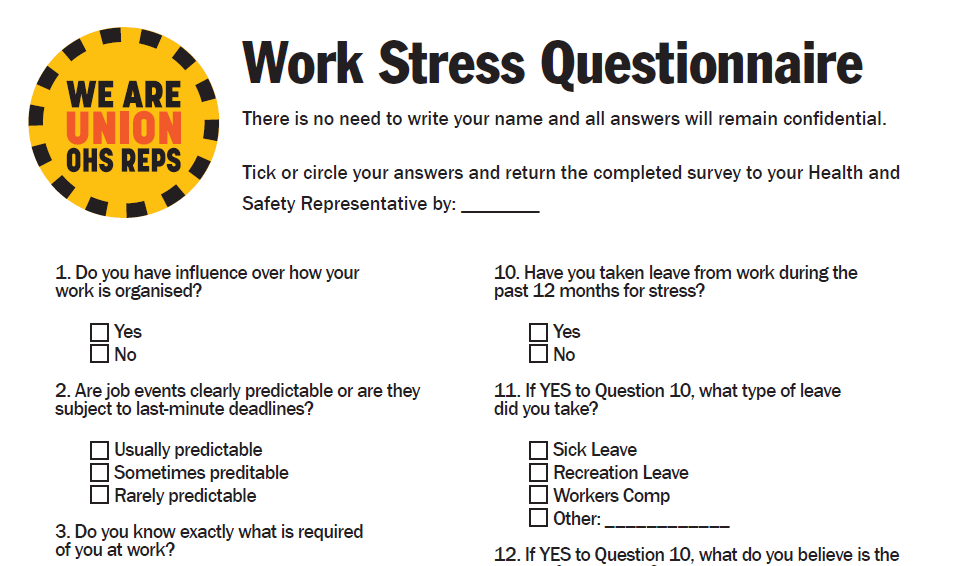The trade union approach to stress follows the principles of our preferred order of hazard control measures.That is, the emphasis must be on eliminating or reducing the hazard at its source. This is consistent with the objects of the Victorian Occupational Health and Safety Act, 2004.
As with all workplace hazards, stress should be dealt with in this way:
- Identification of the hazard
- Assessment of the risk
- Control: Elimination or reduction of the risk
- Review and evaluation of any control strategies.
Steps to follow:
- Identify the workplace factors with a potential to cause stress
- You can use the We Are Union: OHS Reps stress questionnaire available below. Print out some copies and distribute them to your DWG to assess the risk level of job stress in your workplace.
- (also see What is Work-Related Stress?), by workplace inspection, discussion with workers; and How to Develop a Survey this example is on Work Load;)
An important stressor in many workplaces is change: remember that the employer has a legal duty under s35 to consult when 'proposing changes that may affect the health and safety of employees, to (..) a workplace; the plant, substances or other things used, and the conduct of the work performed.
Make sure you are involved and participate in the decision making around workplace change.
Another very useful tool for reps is a website with information on the UK's HSE Stress Management Standards. The Management Standards cover six key areas of work design that, if not properly managed, are associated with poor health and well-being, lower productivity and increased sickness absence. In other words, the six Management Standards cover the primary sources of stress at work. - Assess the specific factors, their causes and effects
- Control the hazard by negotiating for changes to the physical work environment or the work organisation. Examples my include the employer:
- Providing adequate control measures against physical pressures
- Identifying and controlling physical hazards at the workplace
- Ensuring there is adequate staffing to do the work
- Developing and implementing policies on reasonable working hours, including overtime
- Changing the way jobs are done, consulting with the OHS reps and workers, giving workers more responsibility, increasing job scope, varying job tasks
- Providing adequate training and support
- Ensuring that policies and procedures are developed in consultation, clearly stated and uniformly applied
- Ensuring there is consultation and cooperation workers and their representatives, especially during periods of organisational change
- Providing scope for flexible and variable working conditions over which people have some control, to increase interest and ownership of the job, and assist people to meet their family responsibilities
- Developing and implementing policies, grievance procedures and investigation of complaints
- Providing training to managers and supervisors in interpersonal skills
- Ensuring all workers are treated fairly and consistently with an intolerance of harassment and bullying
This is known as a 'risk management' approach.
As with other workplace hazards, intervention at a later stage of the stress processes (sometimes called 'stress management') is far less effective. Employers often regard this as the main, or even the only way to deal with workplace stress. In some cases, workers are taught deep breathing exercises or yoga. Regardless of any benefits of deep breathing and yoga, this approach is, in fact, asking workers to fit themselves into adverse working conditions.
SPECIAL PROBLEMS
Some workplaces and occupations pose special problems in eliminating stressors at their source. For instance, nurses and others in the health industry are confronted with trauma, pain, suffering and death. People in emergency services (e.g. firefighters, ambulance officers, police, search and rescue personnel) and social workers are often confronted with tragedies. Sometimes an unforeseen workplace situation creates stress.
These seemingly 'inevitable' situations should not mean an end to identifying the issues but seeking ways of eliminating or reducing the hazards at source or at the path. For example, by administrative measures which rotate tasks, by distancing or isolating some people from the stress factors, or by providing increased security measures. Many supposed 'unforeseen' events could be predicted.
In addition, the following should be considered:
- Appropriate training and preparation that can assist workers who may be confronted with tragic or violent situations.
- Congenial workplace relations in which workers can discuss situations informally with informal settings (sometimes with professional help) to provide mutual support and assistance.
- Professional counselling or 'debriefing' chosen on an agreed basis, which includes a focus on workplace conditions.
Work Safe Queensland has produced a number of very useful resources - of particular use is how to implement a risk management approach to stress. Also useful is the guide: Psychological Health for Small Business. (these can be downloaded on the Resources page)
What if my employer doesn't take action?
If your employer ignores you, does not consult with you or refuses to acknowledge workplace stressors, then take action:
- contact you union for advice/assistance
- raise the issue formally under the Issue resolution procedures
- issue a PIN
